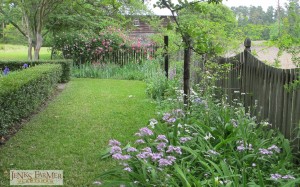Phlox for Parking Lots
Over the past few decades slow changes in the hort industry left old fashioned, home gardening in the shadows. Today, landscapers, growers and customers aim for new, lush and sexy plants, patios, turf and tools. As a friend once told me, “You garden designer types just like to tart things up. Don’tcha?” I was more than slightly insulted.
One of the innovations– those patented, trademarked, plant promotions programs– has, indeed, made money for many people and introduced some great new plants. But those programs have pitfalls: added cost for special tags or pots, untested plants and complex monitoring systems.
Simplicity is good. Simple, old pass-along-plants are great. They just need a make over every once in a while. Tarting up.

Urban Garden: Old fashioned plants in a thoroughly modern garden.This used to be an asphalt parking lot. We removed the pavement and planted. No irrigation, no chemicals; just the right plant in the right place.
In flower it is a joyful, fun little thing. It looks great in small pots, for a long time, in the middle of spring. It has good shelf appeal and shelf life. And it’s so adaptable that it fits many customers’ needs.
And you know how impossible customer needs are to address sometimes:
1. “I need a plant for a spot that is full sun, hot, horrid, like the edge of an asphalt parking lot and white as ashtray sand but floods when it rains…”
2. “I need a pretty little pastel colored perennial that is cheerful around Easter and looks great at the base of azaleas, iris, spirea or roses, and I don’t have to prune….”
3. “I need a container plant for a part shade deck; a plant I don’t have to worry about if I go on vacation for a month and then come back in the fall and want to mix in a few pansies and …..”
Downy Phlox will do it all. I could go on with more examples, but I’ll tell you a bit more about how I used it in those three fairly common situations.
1. Around the edges of an asphalt parking lot, backside of a building on Main Street, Columbia, in a place with no irrigation and little care, this thing thrives. It adds happy flowers under the new bright green leaves of Sand Cord Grass and a pastel quince, in the spring. It tolerates floodwaters that pour off the roof then broil the plants for 24 hours. It makes a dense, green ground cover from March to December.
2. In the perennial border of a home garden in Aiken, I used this as a fast growing ground cover. It was pretty in the spring with the pink flowers of Crinum bulbispermum ‘Jumbo’and lime-green emerging leaves of Japanese maples above. In this new border, the other perennials needed a year or two to really settle in. Downy phlox is fast; it covers the ground, makes things look full and suppresses weeds.
3. In a giant clay pot, with silver-leafed yucca, downy phlox flops over the sides, the tiny purple flowers and silver leaves look perfect together. I cut it off after flowering; it comes back and the two have lived happily for years.
Cultivars
‘Eco Happy Traveler’ Lavender flowers with deeper purple, club shape in
the middle. (Georgia)
‘Forest Frost’Crisp white flowers. (Mississippi)
‘Peach Blossom’ aka ‘Elizabeth Lawrence’ Pink with a white center and a richer pink cross in
the middle. Andrea Sprout, curator of Elizabeth Lawrence garden near Charlotte, says, “Planted in 1957 and still blooms every spring starting mid-late April”. It’s recently been sold in Texas as the cultivar ‘Elizabeth Lawrence’.
‘Slim Jim’Small in all respects. Tiny purple flowers on thread like leaves
but still vigorous. (Texas)
Flowering Dates:
My records show Phlox pilosa in flower in various years from April 2-25 in Zone 8 in Columbia, Aiken and Florence counties.
Companion That Flower at the Same Time
Amaryllis x johnsonii
Crinum bulbispermum ‘Jumbo’
Baptisia ‘Carolina Moonlight’
Azalea, Spirea,
Narcissus ‘Stratosphere’(tall, late perennial daffodil))
Distribution
USC botanist, Dr. John Nelson says downy phlox is probably found in every county in South Carolina. It’s widely distributed, otherwise, west to Texas, south to Florida and north to Ontario.
Dr. Nelson also notes, “Phlox, the genus, was actually one of the first genera studied taxonomically. There are records of it being tended to and cared for (presumably in gardens) in the Middle East at least 2000 years ago. There is even a passage in the Bible, “wherein various taxonomists were watching over their Phlox by night.”


With the weather extremes we’re getting lately, it seems “parking lot” conditions may become standard garden conditions in the South! Nice to have a great tough plant like this to use.